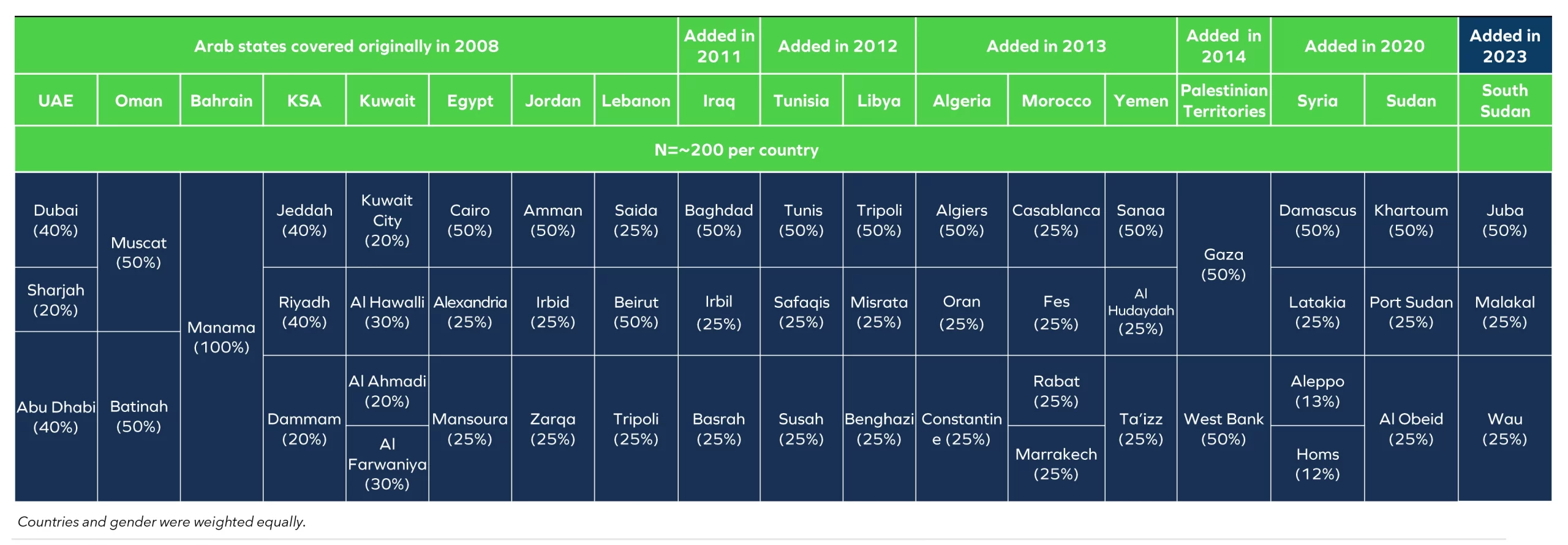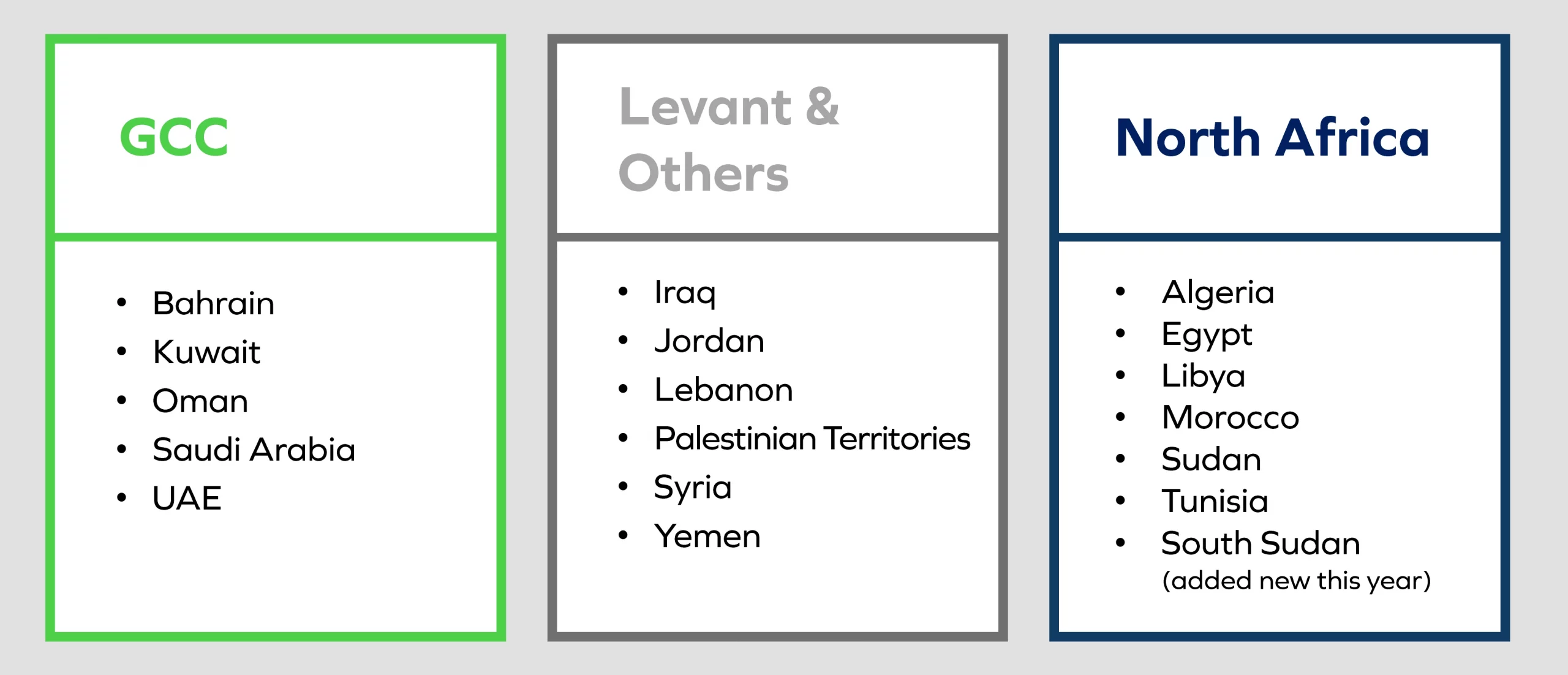Arab youth surveyed
Male/Female
Why we conduct this survey
- To deliver valuable insights on what defines the region – its youthful demographic - with tracking data to show what is changing on the ground
- To provide the key findings of the survey on this website giving governments, the private sector and civil society across the world free access to key information to support policy-making and strategy development To ensure the survey’s independence and credibility, we fund the survey entirely ourselves. Over the last 15 years, we have built a rich library of insights about young Arabs that is accessible to all.
2023 Survey
Methodology
The 15th annual ASDA’A BCW Arab Youth Survey 2023 was conducted among Arab youth across 53 cities in 18 states in the Middle East and North Africa, with South Sudan added this year.
Professional interviewers of Sixth Factor Consulting, a leading research company, conducted 3,600 face-to-face interviews from March 27 to April 12, 2023. The interviews were completed in Arabic and English. Margin of error is +/-1.63% for the total sample and larger for sub-groups. Countries and gender were weighted equally.

Regions covered

The survey covered five of the Gulf Cooperation Council states (Bahrain, Kuwait, Oman, Saudi Arabia and the UAE), North Africa (Algeria, Egypt, Libya, Morocco, Sudan and Tunisia), and the Levant (Jordan, Iraq, Lebanon, Palestinian Territories, Syria and Yemen, with South Sudan added new this year).
The geographic location of respondents was considered when developing the fieldwork methodology with, for example, 40% of UAE respondents in Abu Dhabi, 40% in Dubai and 20% in Sharjah.
Saudi respondents were drawn from three of the country’s main cities, Riyadh, Jeddah, and Dammam; youth in the Palestinian Territories from the West Bank and Gaza; Oman’s youth from Muscat and Batinah; Lebanese youth from Beirut, Saida and Tripoli; Tunisian youth from Tunis, Sfax and Soussa; Iraqi youth from Baghdad, Irbil and Basrah; Egyptian youth from Cairo, Alexandria, and Mansoura, and so on, across each state.
When analyzed, this geographic spread provides a more accurate national picture than findings based solely on the responses of those living in capital cities.
18 Arab States & Territories
Population (mn) 1.87
GDP PPP (US$ bn - 2023 est.) 44.87
Contribution of oil to GDP 10.9%
Youth (15 to 24 years) unemployment (% of total labour force) 6.6%
Internet users (mn) 1.75
Internet penetration ~93%
Active social media users (mn) 1.59
Active social media penetration 85%
Mobile subscriptions (mn) 2.1
Mobile phone penetration 112%
Population (mn) 4.32
GDP PPP (US$ bn - 2023 est.) 164.71
Contribution of oil to GDP 27.6%
Youth (15 to 24 years) unemployment (% of total labour force) 15.4%
Internet users (mn) 4.27
Internet penetration 99%
Active social media users (mn) 4.05
Active social media penetration 93%
Mobile subscriptions (mn) 7.64
Mobile phone penetration 176%
Population (mn) 5.48
GDP PPP (US$ bn - 2023 est.) 104.9
Contribution of oil to GDP 23.5%
Youth (15 to 24 years) unemployment (% of total labour force) 7.5%
Internet users (mn) 5.02
Internet penetration 95%
Active social media users (mn) 4.39
Active social media penetration 83.2%
Mobile subscriptions (mn) 6.99
Mobile phone penetration 127%
Population (mn) 36.9
GDP PPP (US$ bn - 2023 est.) 1060
Contribution of oil to GDP 35.2%
Youth (15 to 24 years) unemployment (% of total labour force) 23.8%
Internet users (mn) 36.31
Internet penetration 99%
Active social media users (mn) 29.3
Active social media penetration 82.3%
Mobile subscriptions (mn) 43.8
Mobile phone penetration 124%
Population (mn) 10.36
GDP PPP (US$ bn - 2023 est.) 498.98
Contribution of oil to GDP 30%
Youth (15 to 24 years) unemployment (% of total labour force) 9.3%
Internet users (mn) 9.99
Internet penetration 100%
Active social media users (mn) 10.65
Active social media penetration 106%
Mobile subscriptions (mn) 19.05
Mobile phone penetration 184%
Population (mn) 11.33
GDP PPP (US$ bn - 2023 est.) 52.06
Contribution of oil to GDP -
Youth (15 to 24 years) unemployment (% of total labour force) 39.4%
Internet users (mn) 9.95
Internet penetration 87%
Active social media users (mn) 6.85
Active social media penetration 60%
Mobile subscriptions (mn) 8.61
Mobile phone penetration 76%
Population (mn) 45.4
GDP PPP (US$ bn - 2023 est.) 267.89
Contribution of oil to GDP 42.8%
Youth (15 to 24 years) unemployment (% of total labour force) 34.6%
Internet users (mn) 33.7
Internet penetration 74%
Active social media users (mn) 28.35
Active social media penetration 62%
Mobile subscriptions (mn) 45.76
Mobile phone penetration 100.7%
Population (mn) 6.7
GDP PPP (US$ bn - 2023 est.) 23
Contribution of oil to GDP -
Youth (15 to 24 years) unemployment (% of total labour force) 47.8
Internet users (mn) 5.67
Internet penetration 84%
Active social media users (mn) 5.06
Active social media penetration 75.2%
Mobile subscriptions (mn) 4.69
Mobile phone penetration 70%
Population (mn) 5.36
GDP PPP (US$ bn - 2023 est.) 18.45
Contribution of oil to GDP -
Youth (15 to 24 years) unemployment (% of total labour force) 40%
Internet users (mn) 3.96
Internet penetration 74.6%
Active social media users (mn) 2.95
Active social media penetration 55%
Mobile subscriptions (mn) 4.4
Mobile phone penetration 84%
Population (mn) 23.12
GDP PPP (US$ bn - 2023 est.) 20.5
Contribution of oil to GDP 4% (2020)
Youth (15 to 24 years) unemployment (% of total labour force) 22.2%
Internet users (mn) 9.25
Internet penetration 40%
Active social media users (mn) 8.5
Active social media penetration 35%
Mobile subscriptions (mn) 15.57
Mobile phone penetration 68.7%
Population (mn) 34.38
GDP PPP (US$ bn - 2023 est.) 19.5
Contribution of oil to GDP 10%
Youth (15 to 24 years) unemployment (% of total labour force) 25.6%
Internet users (mn) 9.1
Internet penetration 26.7%
Active social media users (mn) 3.5
Active social media penetration 9%
Mobile subscriptions (mn) 19.63
Mobile phone penetration 57.6%
Population (mn) 45.54
GDP PPP (US$ bn - 2023 est.) 206.1
Contribution of oil to GDP 14.5%
Youth (15 to 24 years) unemployment (% of total labour force) 29%
Internet users (mn) 32.9
Internet penetration 72%
Active social media users (mn) 26.6
Active social media penetration 58%
Mobile subscriptions (mn) 48.53
Mobile phone penetration 106%
Population (mn) 112.56
GDP PPP (US$ bn - 2023 est.) 387.1
Contribution of oil to GDP 3%
Youth (15 to 24 years) unemployment (% of total labour force) 31.3%
Internet users (mn) 80.75
Internet penetration 72%
Active social media users (mn) 51.45
Active social media penetration 48.9%
Mobile subscriptions (mn) 105.1
Mobile phone penetration 93%
Population (mn) 6.9
GDP PPP (US$ bn - 2023 est.) 46.3
Contribution of oil to GDP 56.4%
Youth (15 to 24 years) unemployment (% of total labour force) 51.5%
Internet users (mn) 3.14
Internet penetration 45%
Active social media users (mn) 6.4
Active social media penetration 91.4%
Mobile subscriptions (mn) 12.5
Mobile phone penetration 181%
Population (mn) 37.8
GDP PPP (US$ bn - 2023 est.) 138.78
Contribution of oil to GDP -
Youth (15 to 24 years) unemployment (% of total labour force) 24.9%
Internet users (mn) 33.18
Internet penetration 87%
Active social media users (mn) 23.8
Active social media penetration 63%
Mobile subscriptions (mn) 50.19
Mobile phone penetration 133%
Population (mn) 47.9
GDP PPP (US$ bn - 2023 est.) 46.71
Contribution of oil to GDP 3.3%
Youth (15 to 24 years) unemployment (% of total labour force) 34.5%
Internet users (mn) 13.49
Internet penetration 28%
Active social media users (mn) 1.3
Active social media penetration 3%
Mobile subscriptions (mn) 35.92
Mobile phone penetration 74%
Population (mn) 11.07
GDP PPP (US$ bn - 2023 est.) 7.01
Contribution of oil to GDP 10.4%
Youth (15 to 24 years) unemployment (% of total labour force) 19.2%
Internet users (mn) 0.77
Internet penetration 6.32%
Active social media users (mn) 0.47
Active social media penetration 4%
Mobile subscriptions (mn) 3.58
Mobile phone penetration 32%
Population (mn) 12.45
GDP PPP (US$ bn - 2023 est.) 49.82
Contribution of oil to GDP 1.5%
Youth (15 to 24 years) unemployment (% of total labour force) 37.1%
Internet users (mn) 9.8
Internet penetration 78%
Active social media users (mn) 8.15
Active social media penetration 65%
Mobile subscriptions (mn) 16.48
Mobile phone penetration 132%
- Population: World Population Review, Worldometers and Populationu.com
- GDP: Central Bank of Bahrain, World Bank, International Monetary Fund; Trading Economics, Palestinian Monetary Authority, Syria Report, and Statista.com
- Contribution of oil to GDP (Oil rent) – World Bank, General Authority for Statistics, KSA, International Monetary Fund
- Youth unemployment: World Bank, UNDP, ILO
- Internet users & penetration; social media users and mobile usage: Internet World Statistics; Data Reportal